2025-11-13 15:35:18
In the standard libc API set there are multiple functions provided that do ASCII numbers to integer conversions.
They are handy and easy to use, but also error-prone and quite lenient in what they accept and silently just swallow.
atoi() is perhaps the most common and basic one. It converts from a string to signed integer. There is also the companion atol() which instead converts to a long.
Some problems these have include that they return 0 instead of an error, that they have no checks for under or overflow and in the atol() case there’s this challenge that long has different sizes on different platforms. So neither of them can reliably be used for 64-bit numbers. They also don’t say where the number ended.
Using these functions opens up your parser to not detect and handle errors or weird input. We write better and stricter parser when we avoid these functions.
This function, along with its siblings strtoul() and strtoll() etc, is more capable. They have overflow detection and they can detect errors – like if there is no digit at all to parse.
However, these functions as well too happily swallow leading whitespace and they allow a + or – in front of the number. The long versions of these functions have the problem that long is not universally 64-bit and the long long version has the problem that it is not universally available.
The overflow and underflow detection with these function is quite quirky, involves errno and forces us to spend multiple extra lines of conditions on every invoke just to be sure we catch those.
I think we in the curl project as well as more or less the entire world has learned through the years that it is usually better to be strict when parsing protocols and data, rather than be lenient and try to accept many things and guess what it otherwise maybe meant.
As a direct result of this we make sure that curl parses and interprets data exactly as that data is meant to look and we error out as soon as we detect the data to be wrong. For security and for solid functionality, providing syntactically incorrect data is not accepted.
This also implies that all number parsing has to be exact, handle overflows and maximum allowed values correctly and conveniently and errors must be detected. It always supports up to 64-bit numbers.
I have previously blogged about how we have implemented our own set of parsing function in curl, and these also include number parsing.
curlx_str_number() is the most commonly used of the ones we have created. It parses a string and stores the value in a 64-bit variable (which in curl code is always present and always 64-bit). It also has a max value argument so that it returns error if too large. And it of course also errors out on overflows etc.
This function of ours does not allow any leading whitespace and certainly no prefixing pluses or minuses. If they should be allowed, the surrounding parsing code needs to explicitly allow them.
The curlx_str_number function is most probably a little slower that the functions it replaces, but I don’t think the difference is huge and the convenience and the added strictness is much welcomed. We write better code and parsers this way. More secure. (curlx_str number source code)
As of yesterday, November 12 2025 all of those weak functions calls have been wiped out from the curl source code. The drop seen in early 2025 was when we got rid of all strtrol() variations. Yesterday we finally got rid of the last atoi() calls.
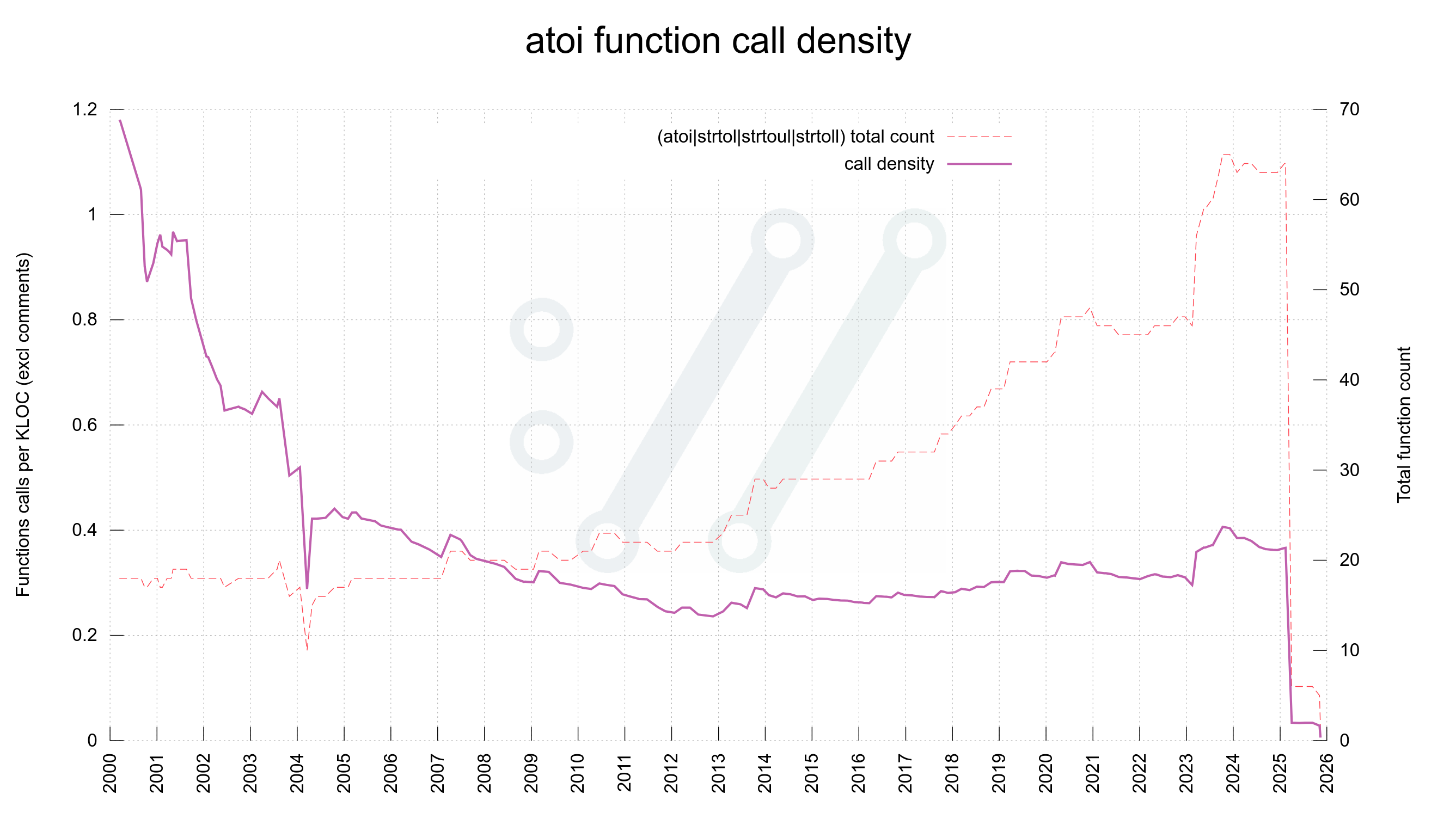
(Daily updated version of the graph.)
The function mentioned above uses a ‘curlx’ prefix. We use this prefix in curl code for functions that exist in libcurl source code but that be used by the curl tool as well – sharing the same code without them being offered by the libcurl API.
A thing we do to reduce code duplication and share code between the library and the command line tool.
2025-11-05 15:04:39
Download curl from curl.se.
the 271st release
11 changes
56 days (total: 10,092)
448 bugfixes (total: 12,537)
699 commits (total: 36,725)
2 new public libcurl function (total: 100)
0 new curl_easy_setopt() option (total: 308)
1 new curl command line option (total: 273)
69 contributors, 35 new (total: 3,534)
22 authors, 5 new (total: 1,415)
1 security fixes (total: 170)
CVE-2025-10966: missing SFTP host verification with wolfSSH. curl’s code for managing SSH connections when SFTP was done using the wolfSSH powered backend was flawed and missed host verification mechanisms.
We drop support for several things this time around:
And then we did some other smaller changes:
--knownhosts to the command line tool%header{} able to output all occurrences of a headerWe set a new project record this time with no less than 448 documented bugfixes since the previous release.
The release presentation mentioned above discusses some of the perhaps most significant ones.
There a small set of pull-requests waiting to get merged, but other than that our future is not set and we greatly appreciate your feedback, submitted issues and provided pull-requests to guide us.
If this release happens to include an annoying regression, there might be a patch release already next week. If we are lucky and it doesn’t, then we aim for a 8.18.0 release in the early January 2026.
2025-11-04 17:27:16
A lot!
One of the most common reactions or questions I get about curl when I show up at conferences somewhere and do presentations:
— is curl still being actively developed?
How many more protocols can there be? This of course being asked by people without very close proximity or insight into the curl project and probably neither into the internet protocol world – which frankly probably is most of the civilized world. Still, these questions keep surprising me. Can projects actually ever get done?
(And do people really believe that adding protocols is the only thing that is left to do?)
There are new car models being made every year in spite of the roads being mostly the same for the last decades and there are new browser versions shipped every few weeks even though the web to most casual observers look roughly the same now as it did a few years ago. Etc etc. Even things such as shoes or bicycles are developed and shipped in new versions every year.
In spite of how it may appear to casual distant observers, very few things remain the same over time in this world. This certainly is also true for internet, the web and how to do data transfers over them. Just five years ago we did internet transfers differently than how we (want to) do them today. New tweaks and proposals are brought up at least on a monthly basis.
Not evolving implies stagnation and eventually… death.
As standards, browsers and users update their expectations, curl does as well. curl needs to adapt and keep up to stay relevant. We want to keep improving it so that it can match and go beyond what people want from it. We want to help drive and push internet transfer technologies to help users to do better, more efficient and more secure operations. We like carrying the world’s infrastructure on our shoulders.
One of the things that actually have occurred to me, after having worked on this project for some decades by now – and this is something I did not at all consider in the past, is that there is a chance that the project will remain alive and in use the next few decades as well. Because of exactly this nothing-ever-stops characteristic of the world around us, but also of course because of the existing amount of users and usage.
Current development should be done with care, a sense of responsibility and with the anticipation that we will carry everything we merge today with us for several more decades – at least. At the latest curl up meeting, I had session I called 100 year curl where I brought up thoughts for us as a project that we might need to work on and keep in mind if indeed we believe the curl project will and should be able to celebrate its 100th birthday in a future. It is a slightly overwhelming (terrifying even?) thought but in my opinion not entirely unrealistic. And when you think about it, we have already traveled almost 30% of the way towards that goalpost.
— I used curl the first time decades ago and it still looks the same.
This is a common follow-up statement. What have we actually done during all this time that the users can’t spot?
A related question that to me also is a little amusing is then:
— You say you worked on curl full time since 2019, but what do you actually do all days?
We work hard at maintaining backwards compatibility and not breaking existing use cases. If you cannot spot any changes and your command lines just keep working, it confirms that we do things right. curl is meant to do its job and stay out of the way. To mostly be boring. A dull stack is a good stack.
We have refactored and rearranged the internal architecture of curl and libcurl several times in the past and we keep doing it at regular intervals as we improve and adapt to new concepts, new ideas and the ever-evolving world. But we never let that impact the API, the ABI or by breaking any previously working curl tool command lines.
I personally think that this is curl’s secret super power. The one thing we truly have accomplished and managed to stick to: stability. In several aspects of the word.
curl offers stability in an unstable world.
Counting commit frequency or any other metric of project activity, the curl project is actually doing more development now and at a higher pace than ever before during its entire lifetime.
We do this to offer you and everyone else the best, the most reliable, the fastest, the most feature rich, the best documented and the most secure internet transfer library on the planet.
2025-10-25 19:26:40
There are those moments in life you know already from the start are going to be the rare once in a lifetime events. This evening was one of those times.
On a dark and wet autumn Friday afternoon my entire family and me dressed up to the most fancy level you can expect and took at taxi to the Stockholm City Hall. Anja my wife and my kids Agnes and Rex.

This was the Swedish Royal Academy of Engineering Science’s (IVA) 106th Högtidssammankomst (“festive gathering”) since its founding in 1919.
Being one the four gold medal recipients of the night our family got a special dedicated person assigned to us who would help us “maneuver” the venue and agenda. Thanks Linus!
In the golden hall me and Anja took a seat in our reserved seats in the front row as the almost 700 other guests slowly entered and filled up every last available chair. The other guests were members of the Academy or special invitees, ministers, the speaker of the parliament etc. All in tail coats, evening dresses and the likes to conform with the dress code of the night.

The golden hall is named after its golden colored walls, all filled up with paintings of Swedish historic figures contributing to a pompous and important atmosphere and spirit. This is the kind of room you want to get awards in.
Part of the program in this golden hall was the gold medal awards ceremony. After having showed short two-minute videos of each of the awardees and our respective deeds and accomplishments on the giant screen in the front of the room, us awardees were called to the stage.
Three gold medals and one large gold medal were handed out to my fellow awardees and myself this year. Carl-Henric Svanberg received the large gold medal. Mats Danielsson and Helena Hedblom were awarded the gold medal. The same as I.
The medals were handed to us one by one by Marcus Wallenberg.
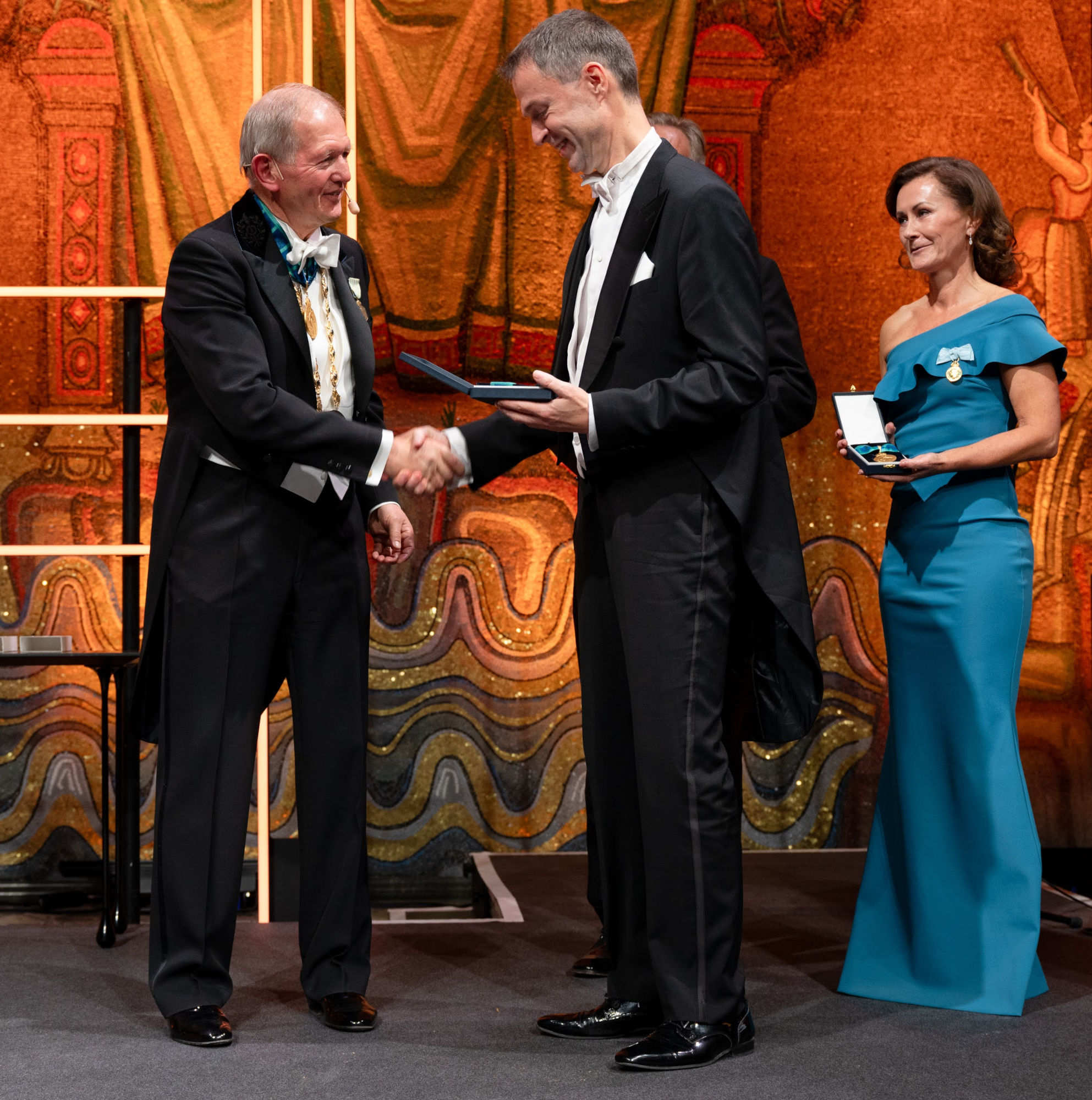
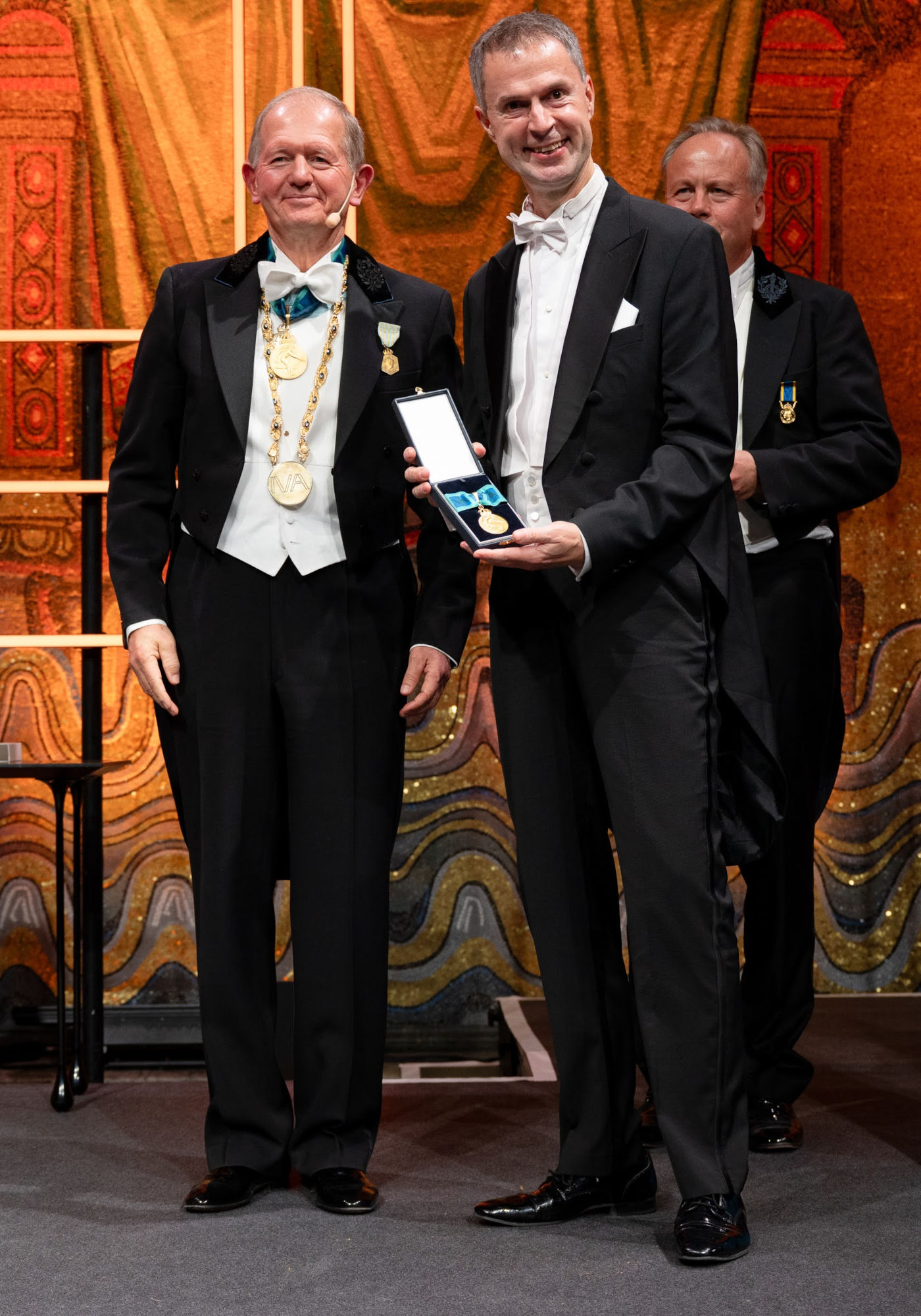
In one of the agenda items in the golden hall,IVA’s CEO Sylvia Schwaag Serger did a much inspiring talk about Swedish Engineering and mentioned an amazing list of feats and accomplishments done over the last year and with hope and anticipation for the future. I and curl were also mentioned in her speech. Even more humbled.
The audience here were some of the top minds and Engineering brains in Sweden. Achievers and great minds. The kind of people you want appreciation from because they know a thing or two.
A small break followed. We strolled down to the giant main hall for some drinks. The blue hall, which is somewhat famous to anyone who ever watched the Nobel Prize banquets. Several people told me the story that the original intent was for the walls to be blue, but…

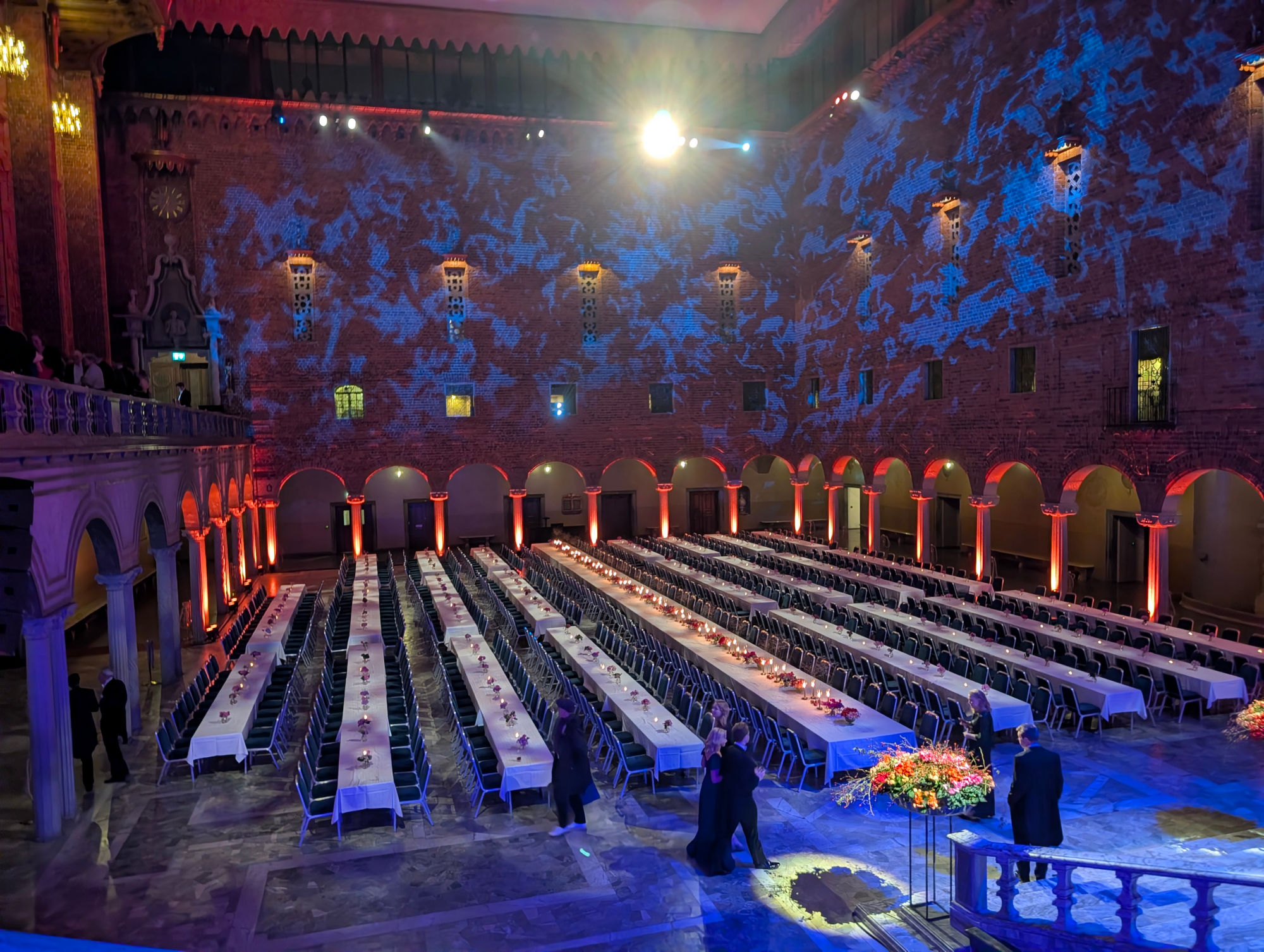
At about 19:00, me and Anja had to sneak up a floor again together with crowd of others who were seated on that main long table you can see on the photo above. Table 1.
On the balcony someone mentioned I should wear the prize. So with some help I managed to get it around my neck. It’s not a bad feeling I can tell you.
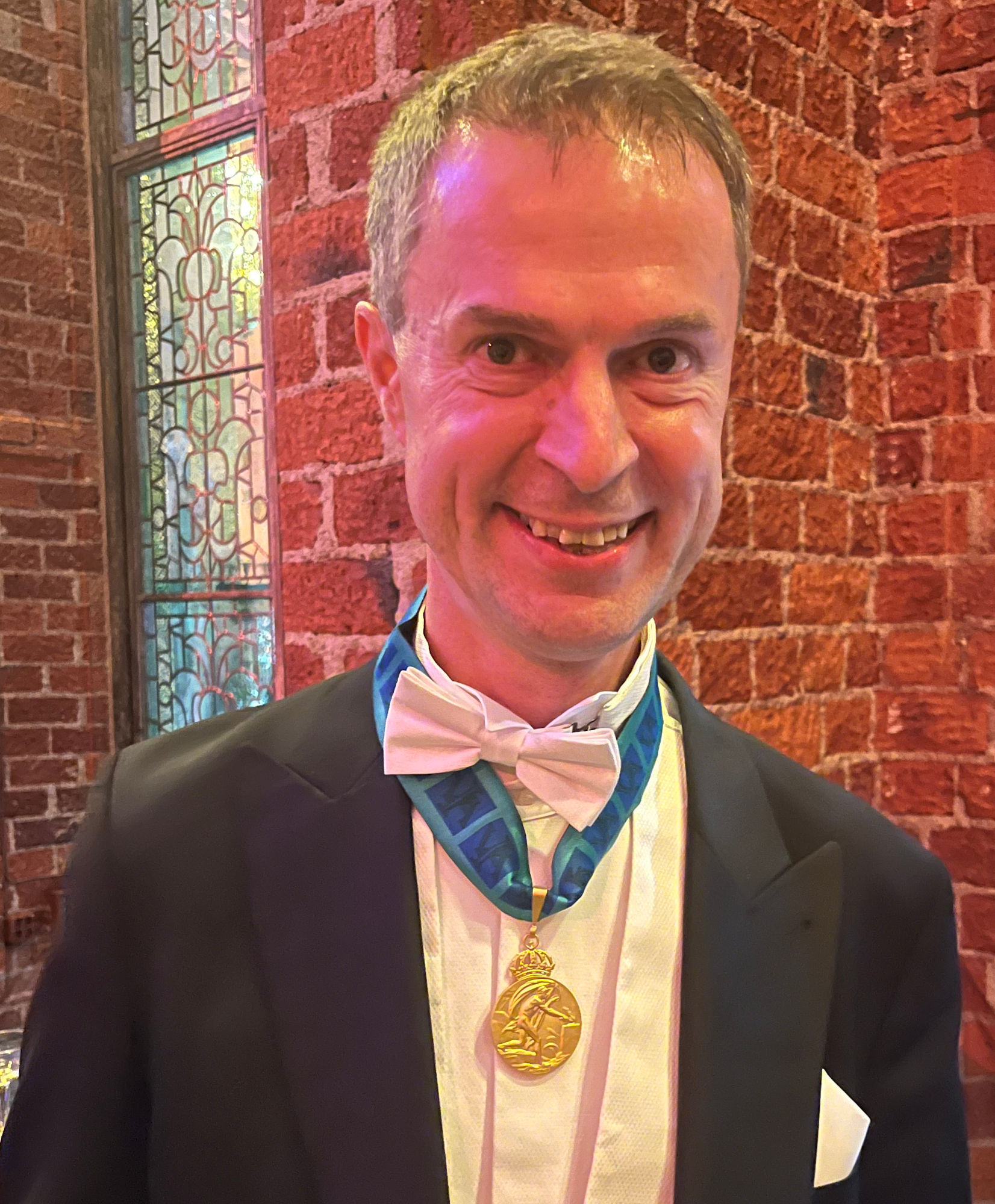
As everyone else in the hall had found their ways to their seats, we got to do a slow procession walking down the big wide stairs down into the main hall and find our ways to our seats.
Then followed a most wonderful three-course meal. I had excellent table neighbor company and we had a lively and interesting conversation all through the dinner. There were a few welcome short interruptions in the form of speeches and music performances. A most delightful dinner.
After the final apple tart was finished, there was coffee and more drinks served upstairs again, as the golden hall had apparently managed to transition while we ate downstairs.

When the clock eventually approached midnight the entire Stenberg family walked off into the night and went home. A completely magical night was over but it will live on in my mind and head for a long time.
Thank you to every single one involved.



The medal has an image of Prometus on the front side, and Daniel Stenberg 2025 engraved on the back side. On the back it also says the name of the Academy and för framstående gärning, for outstanding achievement.
A medal to be proud of.


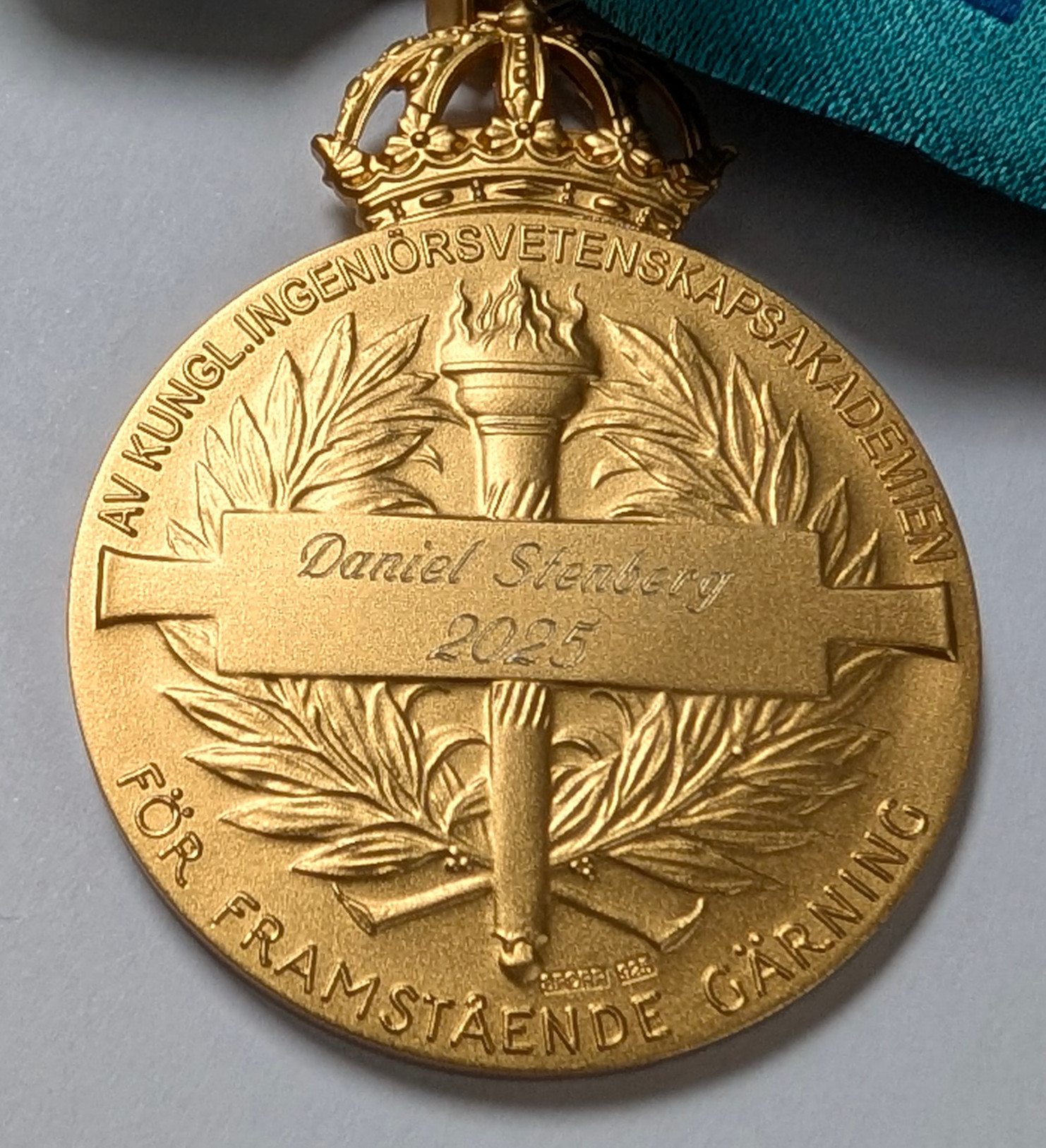
Of course I figured this moment in time also called for a graph.
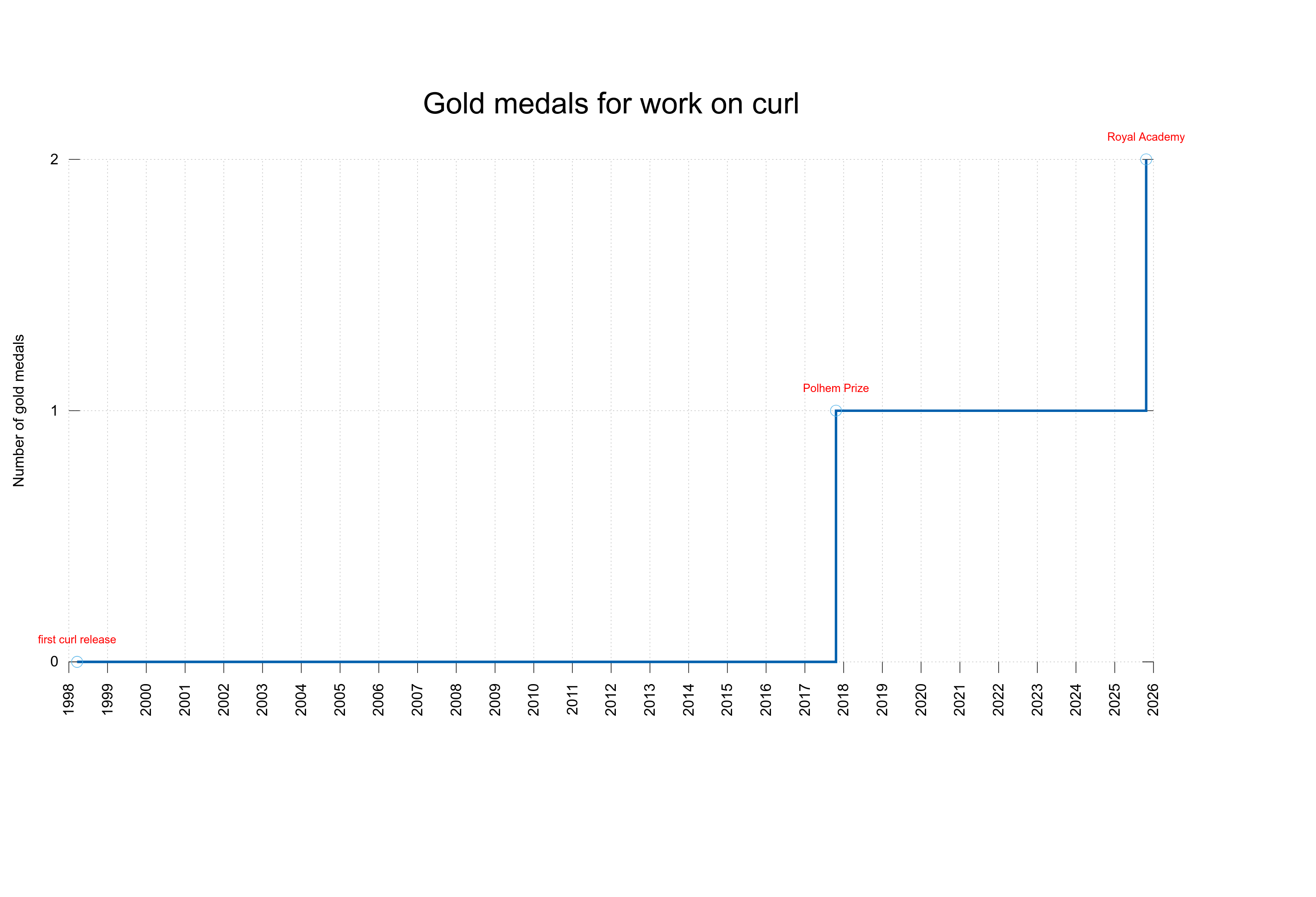
2025-10-23 14:08:37
In November 2022, after I had been keeping track and adding names to this slide for a few years already, we could boast about curl having run on 89 different operating systems and only one year later we celebrated having reached 100 operating systems.
This time I am back with another update and I here is the official list of the 110 operating systems that have run curl.
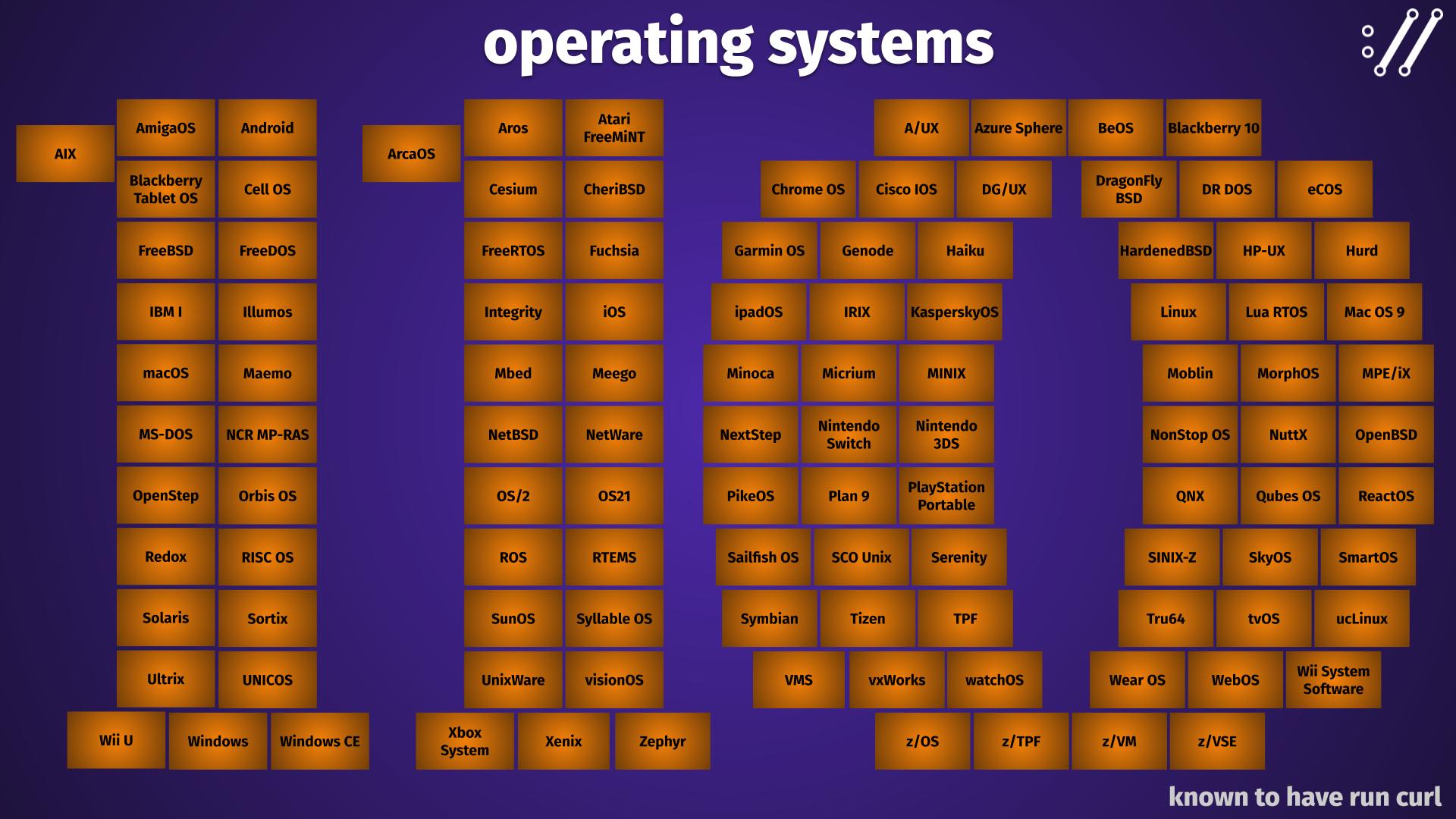
I don’t think curl is unique in having reached this many operating systems, but I think it is a rare thing and I think it is even rarer that we actually have tracked all these names down to have them mentioned – and counted.
For several of these cases, no patches or improvements were ever sent back to the curl project and we don’t know how much or little work that was required to make them happen.
The exact definition of “operating system” in this context is vague but separate Linux distributions do not count as another operating system.
There are probably more systems to include. Please tell me if you have run curl on something not currently mentioned.
2025-10-22 16:08:25
At the AIxCC competition at DEF CON 33 earlier this year, teams competed against each other to find vulnerabilities in provided Open Source projects by using (their own) AI powered tools.
An added challenge was that the teams were also tasked to have their tooling generate patches for the found problems, and the competitors could have a go to try to poke holes on the patches which if they were successful would lead to a reduced score for the patching team.
In order to give the team actual and perhaps even realistic flaws to find, the organizers injected flaws into existing source code. I was curious about how exactly this was done as curl was one of the projects they used for this in the finals, so I had a look and I figured I would let you know. Should you also perhaps be curious.
Would your tools find these vulnerabilities?
Other C based projects used for this in the finals included OpenSSL, little-cms, libexif, libxml2, libavif, freerdp, dav1d and wireshark.
First, let’s paste their description of the curl project here to enjoy their heart-warming words.
curl is a command-line tool and library for transferring data with URLs, supporting a vast array of protocols including HTTP, HTTPS, FTP, SFTP, and dozens of others. Written primarily in C, this Swiss Army knife of data transfer has been a cornerstone of internet infrastructure since 1998, powering everything from simple web requests to complex API integrations across virtually every operating system. What makes curl particularly noteworthy is its incredible protocol support–over 25 different protocols–and its dual nature as both a standalone command-line utility and a powerful library (libcurl) that developers can embed in their applications. The project is renowned for its exceptional stability, security focus, and backward compatibility, making it one of the most widely deployed pieces of software in the world. From IoT devices to major web services, curl quietly handles billions of data transfers daily, earning it a reputation as one of the most successful and enduring open source projects ever created.
There is this website providing (partial) information about all the challenges in the final, or as they call them: tasks. Their site for this is very flashy and cyber I’m sure, but I find it super annoying. It doesn’t provide all the details but enough to give us some basic insights of what the teams were up against.
The organizers wrote a new protocol handler into curl for supporting the “totallyfineprotocl” (yes, with a typo) and within that handler code they injected a rather crude NULL pointer assignment shown below. The result variable is an integer containing zero at that point in the code.

This task had two vulnerabilities injected.
The first one is an added parser in the HTTP code for the response header X-Powered-by: where the code copies the header field value to a fixed-size 64 bytes buffer, so that if the contents is larger than so it is a heap buffer overflow.

The second one is curiously almost a duplicate of task 9 using code for a new protocol:

Two vulnerabilities. The first one inserts a new authentication method to the DICT protocol code, where it contains a debug handler/message with string format vulnerability. The curl internal sendf() function takes printf() formatting options.

The second is hard to understand based on the incomplete code they provide, but the gist of it that the code uses an array for number of seconds in text format that it indexes with the given “current second” without taking leap seconds into account which then would access the stack out of bounds if tm->tm_sec is ever larger than 59:
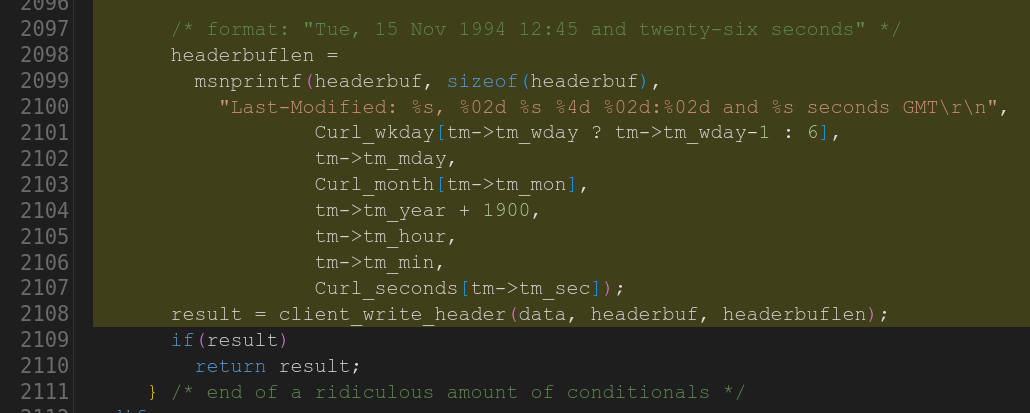
Third time’s the charm? Here’s the maybe not so sneaky NULL pointer dereference in a third made up protocol handler quite similar to the previous two:

This task is puzzling to me because it is listed as “0 vulnerabilities” and there is no vulnerability details listed or provided. Is this a challenge no one cracked? A flaw on the site? A trick question?
Given what I recently have seen what modern tools from Aisle and ZeroPath etc can deliver, I suspect lots of tools can find these flaws now. As seen above here, they were all rather straight forward and not hidden or deeply layered very much. I think for future competitions they need to up their game. Caveat of course that I didn’t look much at the tasks related to other projects; maybe they were harder?
Of course making the problems harder to find will also make more work for the organizers.
I suspect a real obstacle for the teams to find these issues had to be the amount of other potential issues the tools also found and reported; some rightfully and some not quite as correctly. Remember how ZeroPath gave us over 600 potential issues on curl’s master repository just recently. I have no particular reason to think that other projects would have fewer, at least if at a comparable size.
[Addition after first post] I was told that a general idea for how to inject proper and sensible bugs for the competition, was to re-insert flaws from old CVEs, as they are genuine problems in the project that existed in the past. I don’t know why they ended up not doing this (for curl).
I have unfortunately not seen much written in terms of reports and details from the competition from the competing teams. I am still waiting for details on some of their scans on curl.